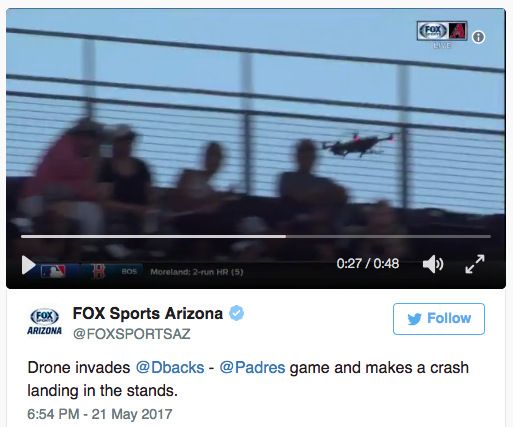How many injuries will it take before the nonsense stops?
As reported in an article by Fitz Tepper at TechCrunch, a personal drone was flown illegally in San Diego on Monday during an MLB game between the Padres and the Diamondbacks. The drone crashed into the stands and was recovered by officials. If you watch the video, it’s fairly clear that it was pure luck that no one was hurt. This was not the same outcome that occurred during a bike race near Sacramento earlier this month. As reported by MarketWatch, an out-of-control drone hit a cyclist who subsequently flipped over his handlebars.
Drone crashes have not yet resulted in fatalities. One of the most severe injuries so far is the loss of an eye by an 18-month-old toddler. As reported by the BBC, a family friend’s racing drone went out of control and one of the propellers cut the child’s right eye.
The MLB incident falls on the heels of a Federal Appeals Court ruling last Friday deciding that current law prohibits the FAA from requiring that hobbyists register their drones. As reported by NBC, the ruling was simultaneously praised by the Academy of Model Aeronautics (AMA) and lamented by the Association for Unmanned Vehicle Systems International (AUVSI). The AMA, representing the hobbyists, has lobbied strongly in support of self-regulation via community-based safety standards organizations (of which there is only one for model aircraft: the AMA). AUVSI, representing the commercial drone industry, is cognizant of the fact that their industry will be significantly negatively impacted WHEN (not if) a drone-induced fatality finally happens.
The AMA lobbied for the hobbyist-exemption language in the 2012 FAA Modernization and Reform Act that has now been litigated. AMA is successfully advocating on behalf of the thousands of responsible hobbyists who feel that self-regulation worked well for many decades and the federal government should not get involved now. However, as I have discussed at length in an old vlog, self-regulation worked well back in the days when you needed a lot of help first to build your model aircraft (almost from scratch!) and then also to learn how to fly it (so that your dozens of hours of sweat equity didn’t immediately crash into balsa splinters). In an era where a few hundred bucks buys you a ready-to-fly quadcopter that literally flies itself, the average owner hasn’t even heard of the AMA much less knows a member or is interested in becoming one.
Stricter regulations are coming whether the AMA likes it or not. There was an era when automobile drivers did not have to have licenses and there was a time when airplanes could fly anywhere their pilots felt like going. Those eras have passed as those niche communities grew and flourished. The FAA has been struggling with the rapid proliferation of consumer drones. A year ago the FAA enacted rules governing the commercial use of small drones. By and large these rules have been well received and commercial drone use is expanding. On the recreational side, however, Congress needs to re-think the blanket exemption they have given to drone hobbyists. It would also be extremely helpful if the AMA could acknowledge the fact that 99.99% of current drone hobbyists are not flying hand-made, balsa-wood radio controlled model airplanes with glow engines that took them dozens of hours to build and dozens more to learn how to fly.

